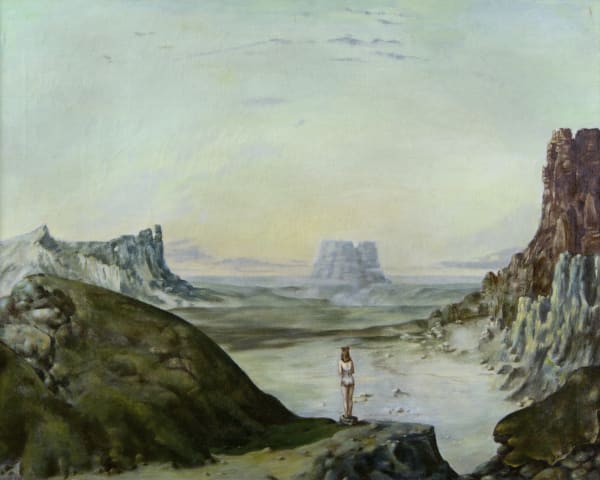-
Dorothea Tanning: Mermaids and Metaphors
Alison Jacques
-
-
One thing which fascinates me when I look at an artist's work is a return to the same subject matter; metaphors or themes, spanning decades or throughout an entire career which they continually revisit. Preoccupied with transitional scenes in which fantasy and reality converge, Tanning’s distinctive metaphors and motifs are often repeated. Despite experimenting with materials and techniques, her objectives remained the same. I don’t see any real divisions. Every one of my paintings is a step on the same road... I see no break or detour, even temporary. The same preoccupations have obsessed me since the beginning (Dorothea Tanning, 1974). In Tanning's 1974 oil on canvas Pour Gustave l'adoré, I am entranced by her magical and mysterious mermaid. Painted in deep greens and ethereal turquoise contours, this aquatic figure presents a poetic but haunting image which we now take time to explore deeper, unearthing Tanning's ongoing fascination with folklore subject matter and what lies beneath.
Dorothea Tanning revisited the same enigmatic mermaid imagery in three separate paintings spanning sixteen years: Pour Gustave l’adoré, 1966, Pour Gustave l’adoré (also known as Dantedoré), 1974, and Dantedoré II, 1982. These works are in part a homage to the nineteenth-century artist Gustave Doré (1832 - 1883), who created a series of illustrations for Dante's Divine Comedy and Coleridge’s The Rime of the Ancient Mariner, of which Tanning kept fully illustrated volumes in her library. Such was Tanning's admiration for Gustave Doré that in May 2001, when Doré's painting Les Océanides (Les Naiades de la mer) came up for sale at The International Art Fair, Tanning acquired it for her own collection. The titles Pour Gustave l'adoré and Dantedoré are a play on the words in French, meaning "Gustave the beloved" and Dante's link to Doré via the illustrations he made. Tanning was clearly intrigued by this water spirit imagery. Her focus on the tail depicted with its shimmering glow, without its human part visible, shrouded in dark waters, suggests themes such as transformation and the unconscious, which resonate in so many of Tanning's paintings throughout her more than seventy-year career.
Victoria Carruthers, author of a newly published monograph on Dorothea Tanning, Transformations, published by Lund Humphries (2020), writes Tanning always had a desire to ‘collaborate’ with the viewer, to share a journey with them and by making her pictures more abstracted, she came closer to capturing what she described as 'unknown but knowable states', moments of movement and intensity without a fixed narrative or meaning. In doing this her work lends itself to multiple interpretations, allowing the viewer to bring something of themselves in every piece. -
In Carruther's essay Mermaids and Metaphors: Dorothea Tanning's Surrealist Ocean, co-authored with Catriona McAra (2014), they write Tanning’s series of mermaids elides the erotic in a number of ways. There is no narrative here, no visible head or body, only a solitary blue-green fishy tail increasingly dissolving into the dark, murky deep of the surrounding water as the scene returns over time. Whilst these works were completed during a period of formalist experimentation with colour, light and a desire to convey emotion over narrative, the deliberate repetition of the same beautiful but melancholy image is, ironically, also a fitting accompaniment to Hans Christian Anderson’s original, violent and very tragic tale (not the Disney version) of the mermaid who gave up everything for a pair of horrifically painful legs, only to find her love unrequited.
In a letter, dated 29 December 1947, the artist and long-time friend of Tanning, Joseph Cornell, wrote I’m in need of and await some flashings of your little mermaid friends who make such exquisite and poetic use of their native metamorphosed element. Have any of their sisters or cousins been showing up lately in any of your work? Cornell goes on to discuss Tanning's painting The Truth About Comets, 1945, interpreting the images of mermaids and girls to be metaphors for the imaginative process and noting their positive effect on his own creativity.
In her new book Fish Out of Water (2020), the writer Claire-Louise Bennett also addresses the feeling of the "oceanic," and is inspired by Dorothea Tanning's Self-Portrait (1944), she remarks Little white waves were rushing onto the promontory, my toes, my feet, my ankles began to tingle and sparkle. 'Everything is a miracle, iridescent, obsessive and alive. Everything is in motion' you said as enticing water swirled about us. 'There are realities that have nothing to do with logic, diving into the subconscious, I call it surconscious - is the way to find them'. Before I could say anything in response, my legs gave way. Just went from under me. It was only when I saw your magnificent flashing fish tail flip up into the air that I began to comprehend what was happening to me...'
As we look at Tanning's deep sea imagery and glittering mermaid's tail, I recall her 2001 autobiography Between Lives, published when Tanning was ninety-one in which she discloses I wanted to lead the eye into spaces that hid, revealed, transformed all at once and where there would be some never-before-seen image, as if it had appeared with no help from me.
-
-

-

Journeys: Chapter One: Dorothea Tanning: Mermaids and Metaphors
Past viewing_room




